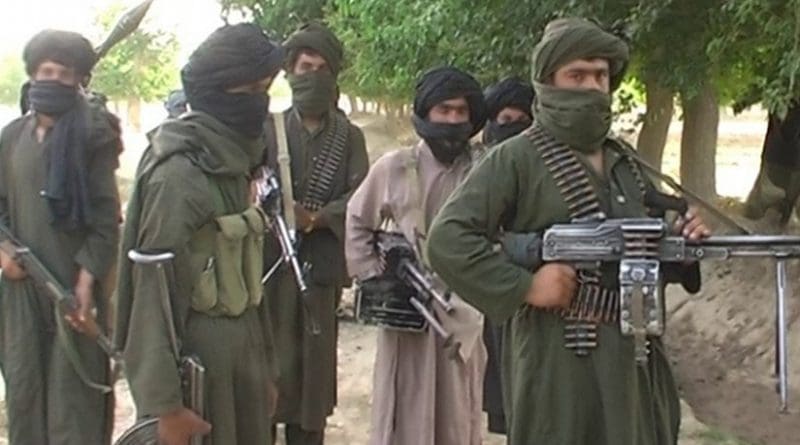Afghanistan: Experts Give Washington Failing Grade On Warlordism Lesson
By Eurasianet
By Rachel Van Horn
After a decade of involvement in Afghanistan, it appears the United States hasn’t learned a critical lesson. Warlordism has been a key component in driving the country’s vicious cycle of violence. Yet as the drawdown of US and NATO troops proceeds, American policymakers find themselves reliant on warlord-led militias to fill security gaps.
“It is enormously short sighted to turn to these militias for stability. It all looks good on paper, but what matters is security, and that’s not happening,” said Rachel Reid, formerly a researcher for Human Rights Watch and currently a senior regional adviser on Afghanistan for the New York-based Open Society Foundations (OSF). Reid made the comments at a recent panel discussion on human rights in Afghanistan, held at New York University. [Editor’s Note: EurasiaNet.org operates under OSF’s auspices].
Warlordism is defined by a central government in Kabul that has a limited reach in Afghanistan’s provinces, giving local power brokers, backed by militia groups, undue influence over developments outside the capital. The phenomenon is widely associated with war crimes and systematic human rights abuses.
The problem with warlordism in Afghanistan stretches back to the 1979-89 Soviet occupation. After driving the Red Army out of the country, and then prompting the collapse of the Moscow-backed Afghan Communist regime in 1992, Mujahedin guerrilla groups, many of which were organized along ethnic or clan lines, carved out spheres of influence and began battling for power among themselves. The instability produced by warlord rivalries paved the way for the rise of the Taliban movement, which by the mid-1990s established control over most of Afghanistan.
Today, with US support, disparate militia groups are once again acting as regional power brokers. As was the case in the early 1990s, the reliance on the militias to provide security and even governance in the regions seems to be more of a detriment than benefit to stabilization efforts.
“Up until 2002, pretty much everyone was happy that the Taliban was gone. In Kabul today, life is better, but in villages around Afghanistan, that’s not the case,” said Anand Gopal, a reporter who has written extensively about the war in Afghanistan. “[Warlords] exist outside the realm of Afghan command.”
Another participant in the October 17 roundtable, journalist Matthieu Aikins, used the example of one Afghan warlord, Abdul Raziq, the police commander in southern Kandahar Province, to highlight the broad problem. In a profile that he prepared for publication in the November edition of The Atlantic, Aikins found that Raziq had links to numerous rights violations, including the mass murder of 15 individuals in 2006, as well as narcotics trafficking. His connection to past atrocities was known to American officials, but that didn’t prevent them from extending US assistance to Raziq’s forces for counterinsurgency operations in Kandahar Province.
“We react as if Afghan violence is something shocking and foreign when in fact we are directly responsible for the way things have unfolded,” Aikins said at the roundtable. “We knew Raziq’s human rights record, and this conscious decision to fund him was made. Human rights are not taken into account in Afghanistan.”
Some rights activists argue that reconstruction and democratization in Afghanistan will be difficult to achieve unless warlords are made to account for their actions. Various calls for the establishment of a truth commission have thus far fallen flat. Such a commission, if ever established, would be limited in scope, however. In 2007, parliament adopted a law that grants immunity to those committing war crimes prior to the Taliban’s 2001 ouster from Kabul.
The roundtable participants made the argument that downplaying justice in favor of stability is a losing strategy. “It’s been underestimated for far too long how much these abuses have actually fueled the insurgency,” explained Gopal. “US strategy is incentivizing insecurity.”
Warlords like Raziq have learned how to profit from US military contracts and how to keep the contracts flowing in. In some cases, they have exaggerated security threats, and, as a result, innocent individuals have suffered. Such behavior has fueled anti-American sentiment and has even expanded the pool of sympathy for the Taliban among the general Afghan population.
“Raziq represents a new generation of warlords — those who have been formed by the logic of the international contracting market,” noted Aikins, “These guys are completely new creatures, and in southern Afghanistan, they are the ones in power.”
Panelists offered a bleak outlook for the future of Afghanistan, especially if the United States doesn’t alter its strategic reliance on warlords. “You’re going to see more anarchy,” said Aikins.

